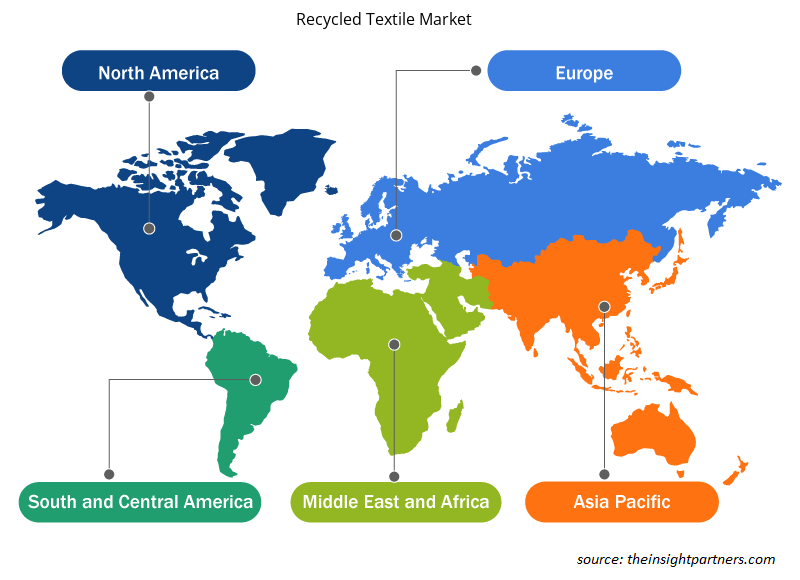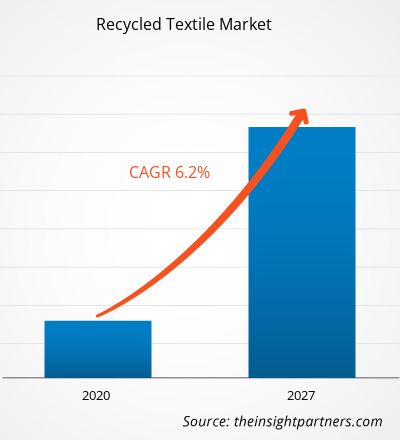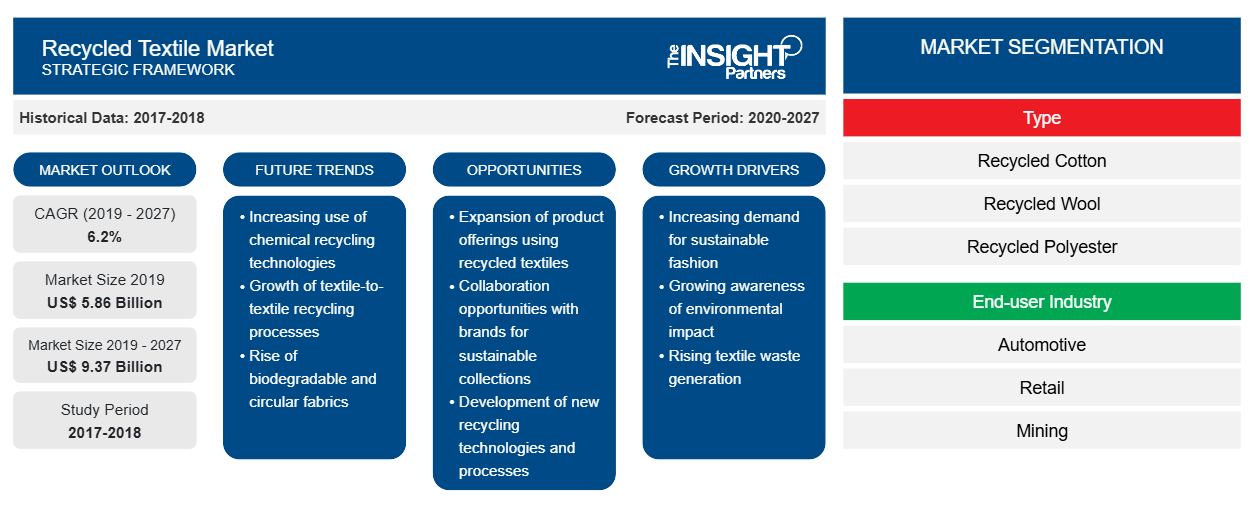بلغت قيمة سوق المنسوجات المعاد تدويرها 5،855.39 مليون دولار أمريكي في عام 2019 ومن المتوقع أن تصل إلى 9،365.04 مليون دولار أمريكي بحلول عام 2027؛ ومن المتوقع أن ينمو بمعدل نمو سنوي مركب قدره 6.2٪ من عام 2020 إلى عام 2027.
المنسوجات المعاد تدويرها هي الملابس القديمة أو غيرها من المنسوجات غير المستخدمة والتي يمكن استعادتها لإعادة استخدامها أو استعادة المواد. في السنوات الأخيرة، كانت هناك مخاوف متزايدة تتعلق بالتخلص من نفايات المنسوجات في جميع أنحاء العالم والتي قد تؤثر سلبًا على البيئة. يتزايد الطلب على المنسوجات المعاد تدويرها في جميع أنحاء العالم مع زيادة الطلب من العديد من الصناعات ذات الاستخدام النهائي بما في ذلك الملابس والأقمشة والسيارات وغيرها. يقوم المصنعون بإعادة تدوير المنسوجات المستخدمة إلى منتج أفضل، والذي يمكن استخدامه في صناعات الاستخدام النهائي المتنوعة، وقد تبنوا العديد من التقنيات. يمكن إجراء إعادة تدوير الموارد بشكل أساسي بمساعدة التقنيات الحرارية والميكانيكية والكيميائية.
أصبحت أوروبا سوقًا مهمًا للمنسوجات المعاد تدويرها بسبب المبادرات الحكومية المتزايدة في المنطقة. علاوة على ذلك، يوفر الطلب المتزايد على منتجات المنسوجات المعاد تدويرها بين صناعة السيارات فرصة مربحة للاعبين في سوق المنسوجات المعاد تدويرها الذين يعملون في السوق. تعد الزيادة في القوة الشرائية إلى جانب تغيير نمط الحياة أحد العوامل الرئيسية الدافعة لنمو سوق المنسوجات في منطقة أوروبا. في أوروبا، يتم إعادة تدوير ما يقرب من 15٪ من الملابس المستخدمة من قبل المستهلك، بينما يتم إعادة تدوير أكثر من 75٪ من الملابس المستخدمة مسبقًا من قبل الشركات المصنعة للاستخدامات الصناعية. ينمو الطلب على المنسوجات المعاد تدويرها في أوروبا بأعلى وتيرة على مدى السنوات القليلة الماضية. يركز منتجو المنسوجات المعاد تدويرها على دول مثل ألمانيا والمملكة المتحدة وما إلى ذلك مما أدى إلى طلب كبير على المنسوجات المعاد تدويرها في منطقة أوروبا. ومن المتوقع أيضًا أن يؤدي التركيز المتزايد للمستهلكين نحو اقتصاد المنسوجات الدائرية إلى تعزيز نمو السوق في المنطقة إلى حد أكبر.
الولايات المتحدة والبرازيل والهند وروسيا وجنوب إفريقيا والمكسيك وإسبانيا والمملكة المتحدة من بين الدول الأكثر تضررًا من حيث الحالات المؤكدة والوفيات المبلغ عنها اعتبارًا من أغسطس 2020. لقد أثر فيروس كورونا المستجد على الاقتصادات والصناعات في مختلف البلدان بسبب عمليات الإغلاق وحظر السفر وإغلاق الأعمال. تعد صناعة المواد الكيميائية والمواد العالمية واحدة من الصناعات الرئيسية التي تعاني من اضطرابات خطيرة مثل انقطاع سلسلة التوريد وانقطاعات التصنيع بسبب تفشي فيروس كورونا المستجد. على سبيل المثال، تعد الصين المركز العالمي للتصنيع وأكبر مورد للمواد الخام لمختلف الصناعات. يؤثر إغلاق العديد من المصانع في الصين والمناطق الرائدة مثل منطقة آسيا والمحيط الهادئ وأوروبا على سلاسل التوريد العالمية ويؤثر سلبًا على التصنيع وجداول التسليم ومبيعات السلع المختلفة. كل هذه العوامل أثرت بشكل كبير على سوق المنسوجات المعاد تدويرها العالمية.
قم بتخصيص هذا التقرير ليناسب متطلباتك
ستحصل على تخصيص لأي تقرير - مجانًا - بما في ذلك أجزاء من هذا التقرير، أو تحليل على مستوى الدولة، وحزمة بيانات Excel، بالإضافة إلى الاستفادة من العروض والخصومات الرائعة للشركات الناشئة والجامعات
- احصل على أهم اتجاهات السوق الرئيسية لهذا التقرير.ستتضمن هذه العينة المجانية تحليلاً للبيانات، بدءًا من اتجاهات السوق وحتى التقديرات والتوقعات.
رؤى السوق
مخاوف متزايدة بشأن التخلص من النفايات النسيجية
تعتبر آلية تصنيع المنسوجات واحدة من العمليات الكيميائية المكثفة التي تولد حجمًا كبيرًا من نفايات المنسوجات طوال عملياتها. يمكن فصل نفايات المنسوجات إلى مجموعتين، نفايات المنسوجات قبل الاستهلاك ومنسوجات ما بعد الاستهلاك. يؤدي ارتفاع كمية نفايات المنسوجات إلى خلق عبئًا على البيئة ويولد مشكلة التخلص الفعال أو حرقها في مدافن النفايات الحالية. وفقًا لتقدير، يعتبر ما يقرب من 10-20٪ من جميع المنتجات النسيجية غير المستخدمة مهدرة. على سبيل المثال، وفقًا لوكالة حماية البيئة الأمريكية، في عام 2015، تم توليد ما مجموعه 15.75 مليون طن من المنسوجات كنفايات صلبة بلدية، تم حرق 19٪ منها، بينما انتهى 65٪ في مدافن النفايات. علاوة على ذلك، يشير تقرير صادر عن وكالة حماية البيئة الأمريكية إلى أن إنتاج المنسوجات والتخلص منها يؤدي إلى انبعاثات غازات الاحتباس الحراري. علاوة على ذلك، تنبعث من عملية الحرق مواد عضوية مثل المعادن الثقيلة والديوكسينات والغازات الحمضية وجزيئات الغبار، والتي تعتبر ضارة بالبشر والبيئة. كما أصبح التخلص من الرماد المتبقي قضية خطيرة لأنه يحتوي أيضًا على تركيز عالٍ من المواد السامة. وبالتالي، من الضروري للغاية إدارة نفايات النسيج بشكل فعال من خلال طرق إعادة الاستخدام أو إعادة التدوير، والتي يمكن أن تعزز استدامة البيئة. في مثل هذه المواقف، يُعتبر إعادة تدوير نفايات النسيج بديلاً قابلاً للتطبيق، مما يساعد في تقليل العبء على الموارد الطبيعية، ويقلل من الحاجة إلى مساحة مكب النفايات ويساعد في توفير الطاقة. علاوة على ذلك، تهدف التشريعات الحكومية الصارمة التي تنظم الإدارة الفعالة لنفايات النسيج إلى تعزيز استخدام إعادة تدوير المنسوجات كبديل مستدام لعلاج المشكلة الوشيكة المتعلقة بالنفايات.
رؤى النوع
بناءً على النوع، يتم تقسيم سوق المنسوجات المعاد تدويرها إلى القطن المعاد تدويره، والصوف المعاد تدويره، والبوليستر المعاد تدويره، والنايلون المعاد تدويره، وغيرها. ومن المتوقع أن ينمو قطاع النايلون المعاد تدويره بأسرع معدل نمو خلال الفترة المتوقعة 2019-2027. يتم تصنيع النايلون المعاد تدويره من البلاستيك الصناعي، والألياف المستهلكة، والنفايات من مصانع النسيج، وشباك الصيد بعد الاستهلاك. يتم تجديدها إلى نايلون جديد، له نفس جودة النايلون الخام. يتم أيضًا تحويل أكياس النايلون، وأقمشة النايلون، وسجاد النايلون إلى نايلون معاد تدويره لمزيد من الاستخدام. تأتي نسبة كبيرة من النايلون المعاد تدويره من شبكات الصيد. إنه بمثابة حل رائع لتحويل القمامة في المحيط. يعد إعادة تدوير النايلون عملية مكلفة مقارنة بالنايلون، لكنها تقدم العديد من الفوائد البيئية. من خلال إعادة تدوير النايلون، يمكن للمرء القضاء على النفايات وتقليل كمية انبعاثات الغازات المسببة للانحباس الحراري من التصنيع. إنه يقلل من الاعتماد على البترول كمصدر للمواد الخام. يساعد استخدام النايلون المعاد تدويره أيضًا في الترويج لتدفقات إعادة تدوير جديدة لمنتجات النايلون التي لم تعد قيد الاستخدام. يتم إذابة معظم المواد المعاد تدويرها ميكانيكيًا في درجات حرارة عالية تؤدي في النهاية إلى تدمير الملوثات وتحويل المواد إلى أشكال قابلة لإعادة الاستخدام. يذوب النايلون في درجات حرارة منخفضة أثناء إعادة التدوير، تاركًا الملوثات وراءه. لذلك، يتطلب النايلون تنظيفًا دقيقًا قبل إعادة التدوير.
رؤى الصناعة للمستخدم النهائي
بناءً على صناعة المستخدم النهائي، يتم تقسيم سوق إعادة التدوير إلى السيارات والتجزئة والتعدين وغيرها. ومن المتوقع أن ينمو قطاع السيارات بأسرع معدل نمو خلال الفترة المتوقعة 2019-2027. تساهم المنسوجات المعاد تدويرها المستخدمة في صناعة السيارات بشكل كبير في إنتاج مكونات السيارات. يشمل استخدام المنسوجات المعاد تدويرها في تطبيقات السيارات مكونات مرئية مثل أغطية الأرضيات والمفروشات وأحزمة الأمان والمنسوجات المعاد تدويرها غير المرئية للمشاهدين مثل الأنابيب والأشرطة وحبل الإطارات ومكونات الوسائد الهوائية والألياف. تُستخدم المنسوجات المعاد تدويرها في صناعة السيارات نظرًا لقوتها الشد والتآكل ونفاذية الهواء ومقاومة الضغط والمرونة وسهولة التنظيف ومقاومة اللهب ومقاومة الظروف المناخية الديناميكية. يستخدم القطن المعاد تدويره في حشو المقاعد أو عزل السيارات.
تعد Anandi Enterprises وChindi وKhaloom Textile India Pvt. Ltd. وKishco Group من بين اللاعبين الرئيسيين في سوق المنسوجات المعاد تدويرها على مستوى العالم. تنفذ هذه الشركات استراتيجيات جديدة لتطوير المنتجات والاندماج والاستحواذ لتوسيع قاعدة العملاء والحصول على حصة سوقية كبيرة في جميع أنحاء العالم، مما يسمح بدوره للاعبين بالحفاظ على اسم علامتهم التجارية على مستوى العالم.
رؤى إقليمية حول سوق المنسوجات المعاد تدويرها
لقد قام المحللون في Insight Partners بشرح الاتجاهات والعوامل الإقليمية المؤثرة على سوق المنسوجات المعاد تدويرها طوال فترة التوقعات بشكل شامل. يناقش هذا القسم أيضًا قطاعات سوق المنسوجات المعاد تدويرها والجغرافيا في جميع أنحاء أمريكا الشمالية وأوروبا ومنطقة آسيا والمحيط الهادئ والشرق الأوسط وأفريقيا وأمريكا الجنوبية والوسطى.

- احصل على البيانات الإقليمية المحددة لسوق المنسوجات المعاد تدويرها
نطاق تقرير سوق المنسوجات المعاد تدويرها
| سمة التقرير | تفاصيل |
|---|---|
| حجم السوق في عام 2019 | 5.86 مليار دولار أمريكي |
| حجم السوق بحلول عام 2027 | 9.37 مليار دولار أمريكي |
| معدل النمو السنوي المركب العالمي (2019 - 2027) | 6.2% |
| البيانات التاريخية | 2017-2018 |
| فترة التنبؤ | 2020-2027 |
| القطاعات المغطاة | حسب النوع
|
| المناطق والدول المغطاة | أمريكا الشمالية
|
| قادة السوق وملفات تعريف الشركات الرئيسية |
|
كثافة اللاعبين في السوق: فهم تأثيرها على ديناميكيات الأعمال
يشهد سوق المنسوجات المعاد تدويرها نموًا سريعًا، مدفوعًا بالطلب المتزايد من المستخدم النهائي بسبب عوامل مثل تفضيلات المستهلك المتطورة والتقدم التكنولوجي والوعي المتزايد بفوائد المنتج. ومع ارتفاع الطلب، تعمل الشركات على توسيع عروضها والابتكار لتلبية احتياجات المستهلكين والاستفادة من الاتجاهات الناشئة، مما يؤدي إلى زيادة نمو السوق.
تشير كثافة اللاعبين في السوق إلى توزيع الشركات أو المؤسسات العاملة في سوق أو صناعة معينة. وهي تشير إلى عدد المنافسين (اللاعبين في السوق) الموجودين في مساحة سوق معينة نسبة إلى حجمها أو قيمتها السوقية الإجمالية.
الشركات الرئيسية العاملة في سوق المنسوجات المعاد تدويرها هي:
- تشيندي
- شركة خلوم للنسيج الهندية المحدودة
- مجموعة كيشكو
- شركة أوشا للخيوط المحدودة
- مؤسسة أناندي
إخلاء المسؤولية : الشركات المذكورة أعلاه ليست مرتبة بأي ترتيب معين.

- احصل على نظرة عامة على أهم اللاعبين الرئيسيين في سوق المنسوجات المعاد تدويرها
تقرير يسلط الضوء على
- تساعد الاتجاهات الصناعية التقدمية في سوق المنسوجات المعاد تدويرها العالمية اللاعبين على تطوير استراتيجيات فعالة طويلة الأجل
- استراتيجيات نمو الأعمال التي تتبناها الأسواق المتقدمة والنامية
- التحليل الكمي لسوق المنسوجات المعاد تدويرها العالمية من عام 2017 إلى عام 2027
- تقدير الطلب العالمي على المنسوجات المعاد تدويرها عبر مختلف الصناعات
- تحليل PEST لتوضيح فعالية المشترين والموردين العاملين في الصناعة للتنبؤ بنمو السوق
- التطورات الأخيرة لفهم سيناريو السوق التنافسية والطلب العالمي على المنسوجات المعاد تدويرها
- اتجاهات السوق وتوقعاتها إلى جانب العوامل التي تدفع وتكبح نمو سوق المنسوجات المعاد تدويرها العالمية
- عملية اتخاذ القرار من خلال فهم الاستراتيجيات التي تدعم المصلحة التجارية فيما يتعلق بنمو سوق المنسوجات المعاد تدويرها العالمية
- حجم سوق المنسوجات المعاد تدويرها عالميا في مختلف عقد السوق.
- نظرة عامة تفصيلية وتقسيم السوق العالمية للمنسوجات المعاد تدويرها، بالإضافة إلى ديناميكياتها في الصناعة
- حجم سوق المنسوجات المعاد تدويرها على مستوى العالم في مناطق مختلفة مع فرص نمو واعدة
السوق العالمية للمنسوجات المعاد تدويرها، حسب النوع
- القطن المعاد تدويره
- الصوف المعاد تدويره
- البوليستر المعاد تدويره
- النايلون المعاد تدويره
- آحرون
السوق العالمية للمنسوجات المعاد تدويرها، حسب صناعة المستخدم النهائي
- السيارات
- بيع بالتجزئة
- التعدين
- آحرون
نبذة عن الشركة
- مؤسسة أناندي
- تشيندي
- شركة خلوم للنسيج الهندية المحدودة
- مجموعة كيشكو
- شركة أوشا للخيوط المحدودة
- شركة هيوسونج
- شركة لي فايبرز
- شركة مارتكس فايبر الجنوبية
- شركة رينيوسيل ايه بي
- مجموعة البوير
- التحليل التاريخي (سنتان)، سنة الأساس، التوقعات (7 سنوات) مع معدل النمو السنوي المركب
- تحليل PEST و SWOT
- حجم السوق والقيمة / الحجم - عالمي، إقليمي، بلد
- الصناعة والمنافسة
- مجموعة بيانات إكسل
التقارير الحديثة
شهادات العملاء
سبب الشراء
- اتخاذ قرارات مدروسة
- فهم ديناميكيات السوق
- تحليل المنافسة
- رؤى العملاء
- توقعات السوق
- تخفيف المخاطر
- التخطيط الاستراتيجي
- مبررات الاستثمار
- تحديد الأسواق الناشئة
- تحسين استراتيجيات التسويق
- تعزيز الكفاءة التشغيلية
- مواكبة التوجهات التنظيمية





















 احصل على عينة مجانية ل - سوق المنسوجات المعاد تدويرها
احصل على عينة مجانية ل - سوق المنسوجات المعاد تدويرها